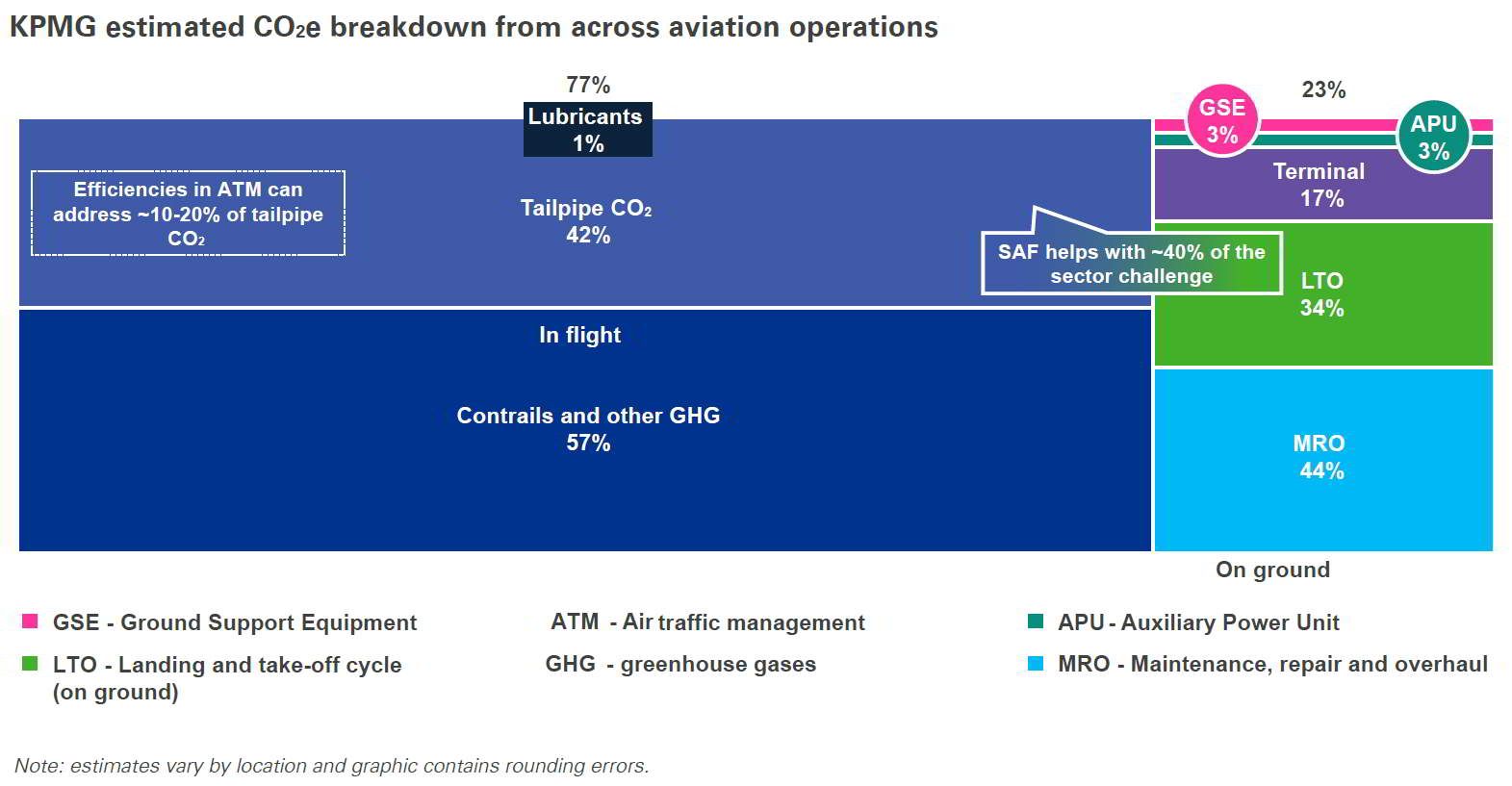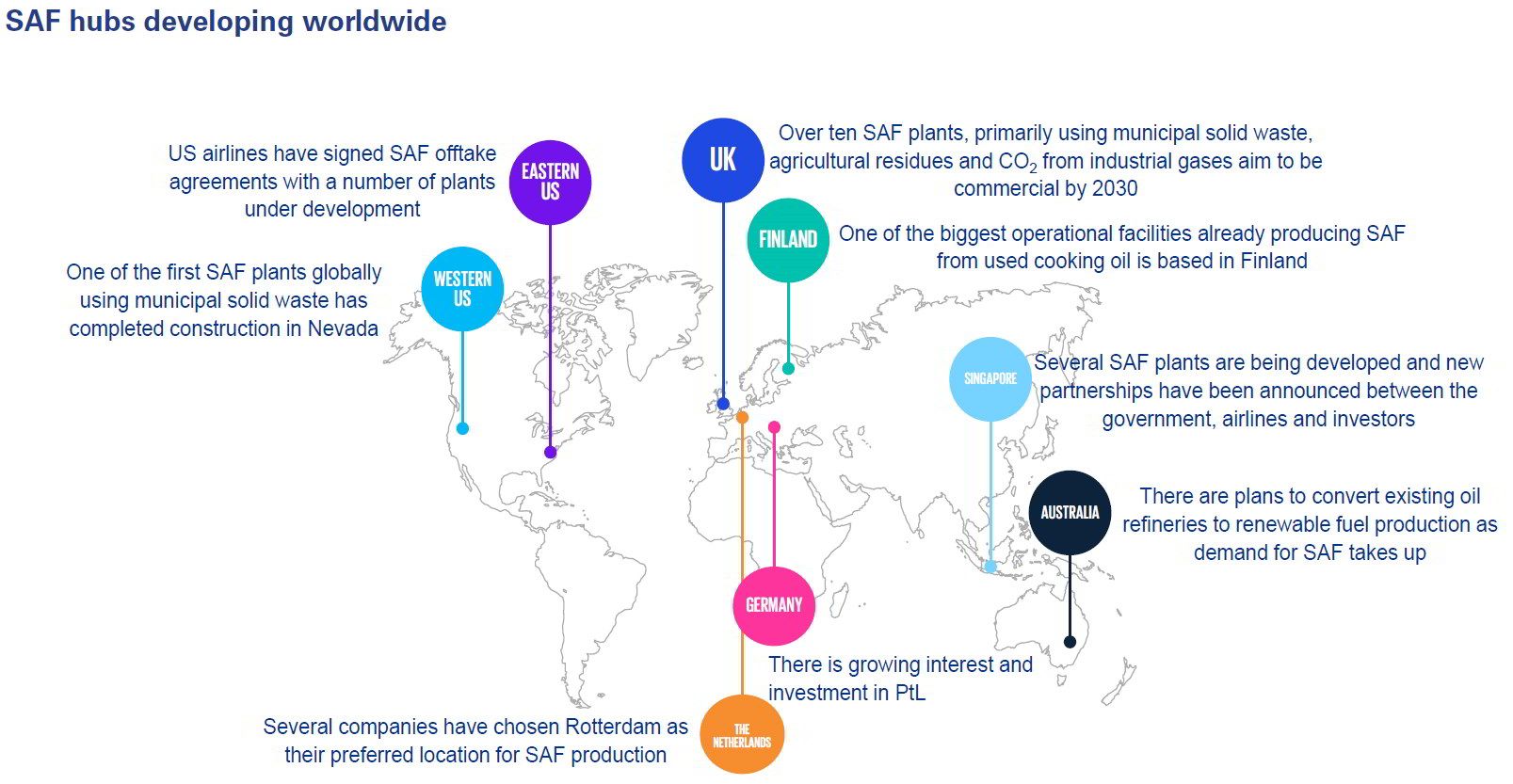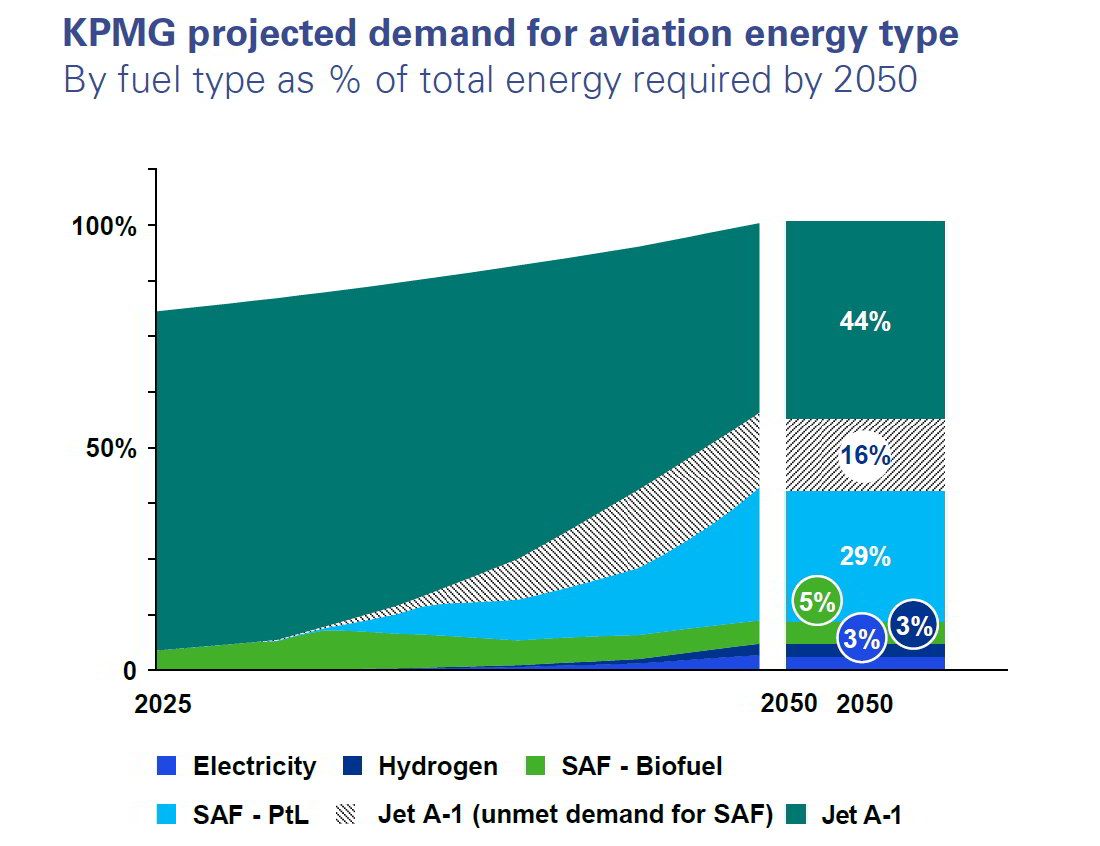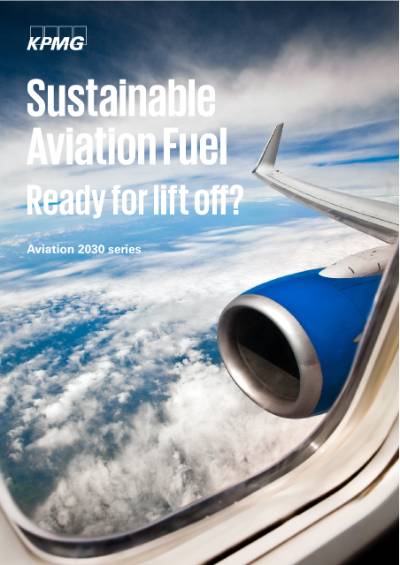With net zero by 2050 now an established objective for aviation worldwide, the sector faces a huge challenge to decarbonise.
At the 41st Assembly of the International Civil Aviation Organization (ICAO) in October 2022, states adopted a collective long-term aspirational goal of net zero carbon emissions by 2050. To put this ambitious vision into practice and quickly curb aviation emissions, expected to rise fast as the sector recovers from COVID-19 disruptions, ICAO, national governments, airlines and industry will need to work even closer to reduce the climate impact of both flying and associated ground operations.
A large share of aviation’s CO2 emissions arise from the combustion of kerosene, known as Jet A-1, in aircraft engines. To avoid this tailpipe CO2 completely a range of solutions, such as hydrogen or batteries, are possible – but these will require a full redesign of aircrafts and new refuelling infrastructure, and may therefore become widespread only after 2050.
Sustainable aviation fuel (SAF) is available today and can be used without the need to develop new planes or engines. These greener jet fuels seek to reduce the lifetime emissions of engine burn, acting as a drop-in fuel that can be blended in increasingly high proportions with conventional Jet A-1. However, the SAF type currently predominant (i.e. biofuels) faces real availability and scalability challenges, as well as supply chain bottlenecks and questions over the sustainability of feedstocks.
With these barriers in mind, our view is that power to liquid (PtL) synthetic fuel, obtained from low-carbon hydrogen and CO2, represents the most scalable product for use long term and a yet untapped solution for the aviation market. As PtL fuel is significantly more expensive than any other SAF, realising its potential cannot be achieved without major investment in electrolysis and carbon capture technology development and deployment.

SAF demand and supply
Like most of the low carbon road fuels blended with petrol today, SAF can be used in existing planes and engines. While SAF is very similar to conventional kerosene, it delivers substantially lower greenhouse gas emissions (GHG) than Jet A-1– typically around 80%.
These emissions are saved throughout the production process, as feedstocks used to make SAF have lower lifecycle carbon emissions than fossil jet.
Given that significant CO2 savings can be achieved with existing fleets, voluntary demand for SAF by airlines is growing rapidly, driven by corporate carbon reduction targets, mounting policy attention, and some passenger interest. Many airlines are already seeking to secure supplies over multi-year periods. This demand will firm up during the 2020s as national SAF mandates come into effect – especially from 2025 onwards – with a focus in Europe and an evolving picture in the rest of the world.
Mandates and targets
Mandates are likely to start low but tighten rapidly during the 2030s and beyond. EU regulators are leading the charge: jet fuel supplied to EU airports will need to be 2% SAF by 2025, increasing at 5-year intervals to reach 63% in 2050, of which 28% would consist of e-fuel. Sweden, Norway, and France all have their own SAF mandates in place and the UK has announced plans for a mandate to be introduced in 2025, reaching 10% SAF by 2030.
Meanwhile, the US has set a SAF production target instead, of at least 3 billion gallons per year by 2030, supported by a mix of tax credits (a maximum of $1.75 per gallon for SAF) and new funding for SAF R&D. California, whose Low Carbon Fuel Standard sets the global standard for SAF incentivization, has recently passed legislation mandating that SAF should comprise 20 percent of aviation fuel consumed in the state by 2030.
Where demand mandates do not yet exist, industry is taking some voluntary initiative, with a number of partnerships announced between major airlines and fuel suppliers to trial or regularly use SAF. There are already industry-led initiatives committing dozens of operators to net zero targets, with some (e.g. the WEF’s Clean Skies for Tomorrow coalition) translating those into explicit SAF blending mandates (e.g. 10% by 2030). Governments are also aware that domestic SAF production offers fuel security as an additional benefit – a point rising quickly up the policymaking agenda.
To meet this increasing demand, SAF production facilities are being constructed, announced or developed around the world. At present, the dominant SAF feedstock is vegetable oil, either virgin or waste oil from cooking. This is converted into synthesized paraffinic kerosene from hydroprocessed esters and fatty acids (HEFA).
GHG savings are achieved when the feedstock is grown, as it captures CO2 during the process. HEFA is the simplest and cheapest form of SAF, and the technology is already commercial today, but its availability will be limited by overall feedstock supply as well as by the ongoing use of oil feedstocks in road and maritime fuel – where fuels are less complex to produce and therefore offer easier profit potential than refining to SAF specifications.
Feedstock prices – hard hit by the Ukraine war – currently represent the majority of the final SAF price. Their volatility can therefore create feedstock supply problems for producers.

Existing and planned SAF capacity and supply barriers
Many HEFA feedstocks are monocrops, reliant on fertilizers, that also suffer from association with biodiversity reduction and are vulnerable to climatic and geopolitical price shocks – as the invasion of Ukraine has thrown into sharp relief.
In the lead-up to 2030, we expect to see a surge in the supply of fuel made from alternative biogenic and non-biogenic waste feedstocks including agricultural residues, used tyres and municipal solid waste (MSW). These will be transformed into SAF through more advanced processes such as alcohol-to-jet, pyrolysis and gasification-Fischer- Tropsch. Greenhouse gas savings are more complex to assess in cases where non-biogenic waste is used, though other benefits can be realized such as avoided waste to landfill. However, feedstock constraints are once again a risk: wastes including MSW are sought by other sectors, such as incineration and bioenergy with carbon capture and storage, making supply finite and competitive.
The constraints faced by these waste-to-fuel production pathways mean that the total SAF yield globally will increase but will still be relatively limited, especially in the coming decade. Blending mandates that are too aggressive too early therefore run the risk of spiking SAF prices and/or driving buyout penalties as they force demand to run ahead of supply. This may deter further investment from airlines as the price of SAF relative to Jet A-1 remains one of the major barriers to its adoption. As a result, there remains a significant risk that SAF production levels are unable to meet current expectations.This risk does offer considerable upside for investors, who can benefit from inflated prices as long as demand outstrips supply (which is likely to last for 20+ years).
The synthetic opportunity
To achieve significant SAF scale-up an exponential expansion of e-fuels or ‘power to liquid’ will be needed.
E-fuels are produced using low-carbon hydrogen (produced from biogas or renewable / nuclear electricity electrolysis) and captured CO2. As such, lifecycle carbon savings from e-fuel can achieve over 90% compared with fossil Jet A-1. In theory, e-fuels have far higher supply potential than other SAF types, given that electricity and CO2 are not restricted by feedstock availability in the same way. The catch is that e-fuels are highly energy-intensive to produce, very expensive and dependent on the rapid expansion of clean electricity production (renewable and/or nuclear) and carbon capture technology globally.
More positively, this interaction with electricity and CO2 sources potentially broadens the landscape for investors, with options to look along the value chain from energy generation and hydrogen production to e-fuel synthesis. As many industrial clusters producing low carbon hydrogen and capturing carbon quickly develop worldwide, the integration of SAF offers an opportunity for further synergy and investment.
As such, of the SAF types on offer, it is our view that PtL offers the greatest opportunity for decarbonization at the scale the sector requires. PtL produces a highenergy- density fuel that is both more scalable and cleaner than other SAF types, provided that the energy used for the conversion processes is derived from lowcarbon sources, and the carbon from climate neutral sources (such as direct air capture – DAC – or other industrial processes). Importantly, PtL plants also offer an opportunity to hedge against the eventual likely demand for different fuel types, e.g. hydrogen – an advantage they have over other SAF types.
Rapid expansion of PtL production will involve both hydrogen electrolysis capacity and commensurate increases in DAC to provide the necessary volumes of CO2 feedstock. Given the sizeable risks involved, this will need to be achieved through industry collaborations across the supply chain and be supported by government actions to incentivize both DAC and PtL. So far, examples include the Airbus partnership with the SAF+ Consortium in Canada, the Liquid Wind consortium in Scandinavia, HyshiFT Consortium in South Africa, and the EU’s recently-announced project Take-Off, which aims to feasibility assess the technical, environmental and economic performances of PtL production. To capitalize on the expected cost reductions of PtL and scale up the technology exponentially, investment is needed now.

Cost competitiveness
Future cost competitiveness of SAF with Jet A-1 and the timescale at which this is achieved depends heavily on government regulation pricing CO2 emissions appropriately, learning effects and ancillary instruments such as book and claim markets for SAF usage.
The current price differential between Jet A-1 and SAF is estimated from a few percentage points at one extreme (where US incentives are at play) to up to five times. While it remains cheaper for airlines to offset carbon emissions through trading schemes than through the use of SAF in place of Jet A-1, we do not expect SAF supply to meaningfully exceed government-mandated levels. Our modelling suggests that such a pivot point may not be reached before 2040 at the current projected rate of carbon pricing increase. Much hinges on economies of scale and the expected reductions in the cost of SAF as technology is deployed, but whether producers can do this remains to be seen. In the meantime, airlines will have to decide how to distribute the costs of rising SAF usage – debates which may have serious implications for low-cost carriers business models.
Moreover, the length of this time horizon raises important questions about the shape of the future regulatory landscape. We expect the regulatory approach to aviation emissions to evolve significantly over the coming decade, and today’s focus on SAF is likely to be joined by new priorities and approaches as decarbonisation strategies are fleshed out. Direct carbon emissions will be eclipsed by total sector CO2 equivalent (CO2e) as the primary concern for regulators, expanding attention to contrails management and the tracking thereof, alongside the focus on ever-higher SAF blends.
Conclusions
At present we are seeing a race by airlines to secure access to HEFA supplies, both to meet immediate voluntary demand and as a natural hedge against expected supply mandates from 2025 onwards.
Meanwhile, a number of advanced fuel technologies have already evolved from concept and prototype to demonstration phase, and are seeking further investment to achieve commercial scale. Wider commerciality of these facilities will reduce cost and increase the affordability for end users, but this is contingent on multiple feedstocks challenges being overcome.
We believe PtL will be therefore instrumental to truly unlocking greater SAF use, and investors will need to consider this long-term technology outlook alongside promoting sustainable, short-term HEFA supply. Different market players are facing different barriers but to capitalize on their opportunities and accelerate investment in SAF, in particular PtL, there are actions that can be taken and risks to be mitigated.
Opportunities
- Airlines: Investing in and using SAF will contribute to reducing the impact of flying and ensure corporate sustainability commitments and increasing expectations from passengers are met.
- Fuel producers: For existing refineries and oil and gas majors, SAF represents a significant opportunity to retain and utilize existing expertise and infrastructure while driving decarbonisation of the business, diversifying from oil investment and providing a positive story. There are also opportunities for new market entrants to gain visibility and secure early-mover advantage while a limited number of competitors produce SAF.
- Energy generators: The availability of excess renewable electricity or nuclear power offers an opportunity to energy generators and utilities to optimize and flex supplies, diversify investment portfolios and tap into a new market. Generators can benefit from earlymover advantage, efficient energy-andfuel integration and strong track-record that can facilitate investment.
- Airports and fuel distributors: Ensuring availability of SAF close to airports serving the most carbonintense routes and, in the future, more capillary distribution can reduce logistic barriers and facilitate SAF usage.
- Lessors and investors: SAF, especially PtL fuel, provides an opportunity for the aviation finance community to diversify risk within a sector they already understand well, pre-empting future environmental scrutiny on the wider aviation value chain.
- Regulators and policy-makers: SAF is key to decarbonizing air transport and its widespread use contributes significantly to national and international carbon emissions reductions targets. Local SAF production and use can improve a country’s fuel security and foster domestic supply chains, retaining fuel expertise, infrastructure and skills and creating new jobs, industrial development and additional inward investment.
Actions needed to scale up SAF supply
- Airlines: Secure early SAF supply by using floating marketindexed pricing mechanisms and consider potential for strategic investments in SAF production. Push for stronger SAF sustainability credentials and ensure transparency when promoting the technology to passengers, to secure their buy-in. Advocate for government support and strategic clarity on advanced fuels technologies.
- Fuel producers: Secure offtake agreements with airlines – derisk by courting new sources of funding, e.g. the aviation finance community, the green finance community. Ensure project development plans represent credible propositions to achieve commercialisation and provide confidence to investors. Work jointly with competitors to share lessons learned at different stages of plant development (from feasibility stage to commercialisation), helping to reduce technology risk and reassure the market that SAF can be delivered.
- Energy generators: Partner with SAF producers to de-risk SAF investment, acquire expertise and technology and familiarize with the fuels and aviation markets.
- Airports and fuel distributors: Prepare and ensure the supply chain can accommodate both fossil jet and SAF, and the latter can be delivered timely and safely to the airport or to the aircraft, if requested. Ensure SAF is available where demand requires by expanding delivery and storage infrastructure, both in proximity of main hubs and, in the future, in more remote locations. Facilitate SAF traceability and reporting initiatives. Absorb some of the cost premium airlines bear for SAF by introducing innovative refuelling schemes (e.g. reduction in landing charges).
- Lessors and investors: Consider opportunities to explore low carbon fuels through commercial due diligence and market screening of suitable technical partners.
- Regulators and policy-makers: Plan for ambitious SAF uptake targets to set the direction for the market, drive investment and facilitate SAF scale-up. Introduce both supply side incentives and demand mandates, as well as book and claim certification schemes. Ensure regulatory clarity and support policies that penalize actors who are noncompliant. Align national policies internationally, where possible, including structures for traceability, reporting, verification, point of sale and generating credits. Fund research and trials to strengthen scientific evidence on the non-CO2 impacts of SAF, rewarding non-CO2 savings appropriately and supporting operational efficiencies and airspace modernisations to maximize the advantages of SAF.
Actions needed to drive PtL investment specifically
- Airlines: Jointly prioritize offtaking agreements with SAF projects that primarily use or aim to incorporate PtL. To reduce higher PtL costs in the short term that may deter airlines’ investment, airlines could partner with each other thus reducing the size of each airlines’ contribution.
- Fuel producers: Scale up development of standalone PtL plants or integration of PtL within other facilities to share infrastructure (e.g. Fischer-Tropsch). Explore ways of capturing CO2 from the SAF production process and reutilising or selling it to produce PtL. Explore partnerships with industrial clusters.
- Energy generators: Trial conversion of renewable electricity or nuclear energy to fuel during off-peak times to showcase PtL as an available and viable technology. Plan, alongside regulators, for greater electricity grid capacity to sustain significant green electricity demand from PtL.
- Airports and fuel distributors: Facilitate the distribution of PtL fuel ensuring PtL plants and airports are well connected and logistical barriers are reduced.
- Lessors and investors: Support the establishment of innovative ways of financing that reduce PtL fuels’ technology risks and drive cost reductions.
- Regulators and policy-makers: Introduce submandates or tailored incentives (e.g. adhoc funding) to drive uptake of PtL.
Relevant SAF risks and mitigation
- Airlines: SAF is more expensive than conventional kerosene and may result in an increase to air ticket prices. Airlines will need to bring consumers with them on the journey to sustainability to ensure transparent pricing and communications. To reduce the risk that projects may not deliver fuel as agreed, airlines may look to diversify their portfolio, both geographically and technologically, and de-risk investments as part of consortia with long-term fixed price certainty for agreed volume ranges.
- Fuel producers: Developing a project but failing to secure capital to progress to construction may stifle investment and confidence in individual project’s capabilities and in the wider sector. SAF projects should therefore look to reduce the existing and perceived barriers, aiming to strengthen their current proposition and facilitate the flow of capital. Projects should consider alignment with local longterm policy and technology direction to decide whether to invest on advanced fuels or PtL, keeping in mind that firstmover- advantage has already passed on the former, while still to play for on the latter. Projects should consider integrating carbon capture into SAF production facilities to improve the carbon credentials of the fuel produced and hedge against future changes in carbon pricing / emission trading schemes policy.
- Energy generators: Green electricity use should not be diverted from the grid to produce SAF unless electricity demand allows this. PtL production specifically should therefore take into consideration electricity demand from more urgent to decarbonize sectors, for example to support the electrification of vehicles and heating. A system-integrated approach where multiple parties work together to make best use of electricity in line with demand can help decarbonize both the energy and aviation sectors.
- Airports and fuel distributors: Airports and fuel distributors should ensure SAF is handled, moved and transported safely, appropriately and in line with existing jet fuel or other fuel specifications. As SAF typically gets commingled with conventional jet fuel in specific sites, distribution channels should ensure ad-hoc requests for SAF supply to specific airports or aircraft can be easily fulfilled. With fuel being traded and blended/ moved several times before reaching the aircraft, traceability of SAF molecules as well as sustainability credentials will be necessary to ensure airlines or fuel producers can claim for SAF use or supply and comply with local mandates.
- Lessors and investors: Investment in SAF plants is perceived to be high risk due to the technology risk, feedstock challenges and revenue uncertainty that current SAF project developers face. A wide range of investors should aim to jointly funnel capital towards highly-prospective projects with an aim to demonstrate SAF can be deployed at scale and unlock future capital.
- Regulators and policy-makers: By setting ambitious SAF uptake targets governments can drive SAF investment, but too aggressive mandates or lack of appropriate policy and funding support may spike SAF prices and create supply bottlenecks. This can lead to excessive reliance on buy-outs or similar schemes with no CO2 savings being delivered. Weak sustainability criteria and different monitoring, reporting and verification requirements globally can affect supply and add logistical and administrative complexity. Harmonized international rules can reduce sustainability risks and facilitate compliance with mandates. Care will also be needed to balance policy ambition with local competitiveness in the face of aviation’s international nature.
Meet the authors
Get in touch
The pace of change is challenging leaders like never before. To find out more about how KPMG perspectives and fresh thinking can help you focus on what’s next for your business or organisation, please get in touch with Chris Brown, Head of Strategy. We’d be delighted to hear from you.
Christopher Brown
Partner, Head of Strategy
KPMG in Ireland


